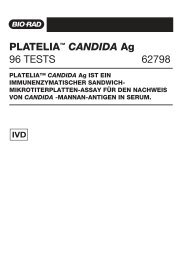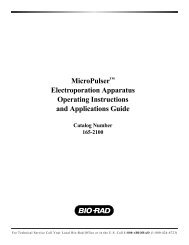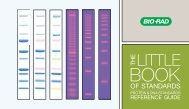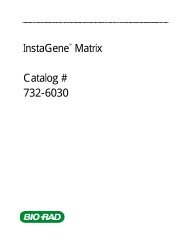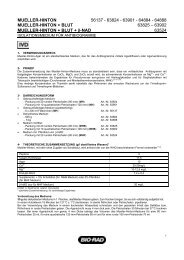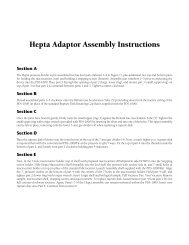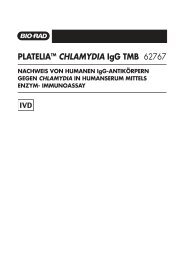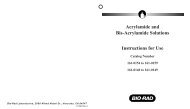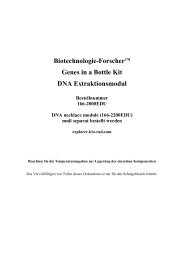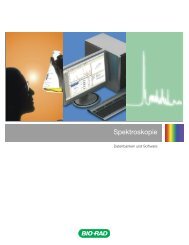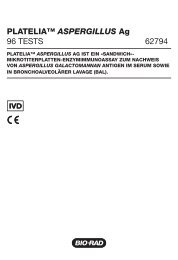Protein Expression and Purification Series - Bio-Rad
Protein Expression and Purification Series - Bio-Rad
Protein Expression and Purification Series - Bio-Rad
Create successful ePaper yourself
Turn your PDF publications into a flip-book with our unique Google optimized e-Paper software.
APPENDIX A<br />
TIPS AND HELPFUL<br />
HINTS<br />
<strong>Protein</strong> <strong>Expression</strong> <strong>and</strong> <strong>Purification</strong> <strong>Series</strong><br />
Appendix A: Tips <strong>and</strong> Helpful Hints<br />
How to get the best protein expression <strong>and</strong> purification<br />
results<br />
1. Culture, subculture, <strong>and</strong> induction<br />
The time frames listed in the instruction manual are designed to have as much flexibility as possible to allow<br />
for classroom time periods. However, when possible, the following guidelines will help you achieve the best<br />
results for cell growth <strong>and</strong> protein expression.<br />
• Initial overnight cultures should be between 14-20 hours rather than 24 hours.<br />
• Induction levels are the highest when induction occurs for four hours.<br />
The figure below shows a comparison of cells induced for four hours versus 24 hours, demonstrating the<br />
clearer induction of the cells induced for four hours.<br />
250 kD<br />
150<br />
100<br />
75<br />
50<br />
37<br />
25<br />
20<br />
15<br />
10<br />
1 2 3 4<br />
Figure 1. Gel comparing four-hour induction to 24-hour induction.<br />
The four-hour induction lane has a much more defined b<strong>and</strong> of<br />
GST-DHFR-His (lane 3, arrow) relative to all of the background E. coli<br />
proteins when compared to 24 hours of induction (lane 4, arrow).<br />
Lane Sample<br />
1 Precision Plus <strong>Protein</strong> Dual Color st<strong>and</strong>ards<br />
2 Uniduced cells<br />
3 Cells induced 4 hours<br />
4 Cells induced 24 hours<br />
2. Stability of induced protein<br />
While the BL21(DE3) E. coli are deficient in some proteases, extra protease inhibitors are not being added<br />
to the cell lysate due to chemical safety.<br />
• After induction of the BL21(DE3) cell culture, the best stopping point for protein stability is after<br />
pelleting the cells <strong>and</strong> removing the supernatant to form what is called a cell paste.<br />
• This cell paste is highly stable when stored at –20°C or –70°C.<br />
3. Lysis of cells<br />
The most efficient lysis of cells requires the cells to be completely resuspended followed by complete<br />
freezing <strong>and</strong> thawing of the resuspended cells.<br />
• Completely resuspend the cell paste in the lysis buffer containing lysozyme. This may require vortexing<br />
<strong>and</strong> vigorous pipeting.<br />
• An ethanol/ice bath is the preferred method of freezing.<br />
• Thaw frozen lysed cells completely before beginning each subsequent freeze-thaw cycle.<br />
• If an ethanol/dry ice bath cannot be used, the freeze-thaw can be accomplished in a –70°C freezer<br />
overnight or by two cycles of overnight freezing followed by thawing using a –20°C freezer. A –20°C<br />
210 Appendix A: Tips <strong>and</strong> Helpful Hints




